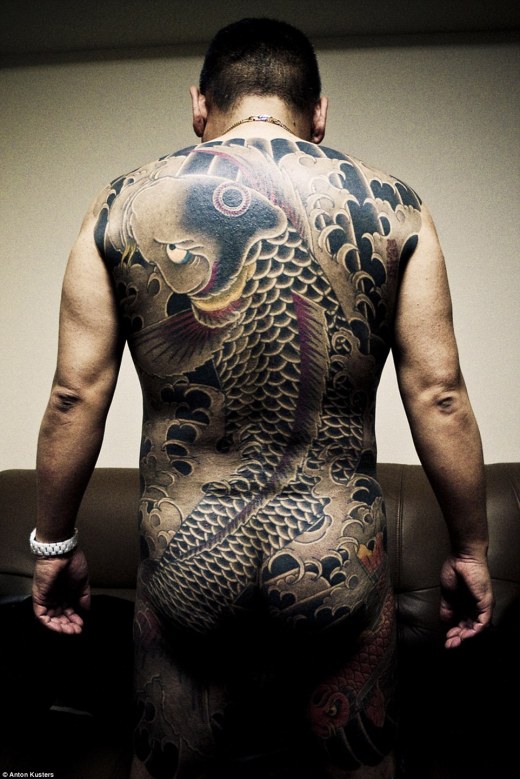
A yakuza displays his full-body irezumi of a koi fish. © Anton Kusters/antonkusters.com
Japanese tattoos are some of the best known and detailed in the world. Their intricacies and the traditional “sleeve” style are worn by millions across the globe, both Japanese and foreigners, but most famously by the yakuza.
Irezumi in Japan originally came from China, where they considered tattooing a form of barbarism and used them to punish criminals. Beginning in the 7th century, criminals in Japan were tattooed to stigmatize and mark them as outcasts for life. By the end of 17th century, tattoos as a form of punishment were slowly phased out in lieu of more traditional punishments.[i] This was partly due to the rise in popularity of decorative tattooing. Many criminals would choose to cover up their punitive tattoos with larger decorative ones. Tattoos also became popular among the physical laborers such as porters and firemen; people who would expose their body to danger. According to legend, the irezumi would toughen the firefighter’s skin and help them endure the heat. [ii] In the 18th century, tattoos were outlawed because of their criminal association and were considered “deleterious to public morals”.[iii] By the Meiji Restoration, tattoos were almost exclusively associated with yakuza. By tattooing themselves, yakuza (1) marked/stigmatized themselves for life; (2) show they have gone through an extremely painful process and have exhibited toughness; (3) are part of the family.[iv]
The traditional irezumi is much more painful than the modern tattoo process, and requires incredible skill. The process involves manually sticking a tebori you no nomi, a stick with several sharp, inked needles attached to the tip, at a precise angle in to the skin. This must be repeated very quickly (120 times/minute) and can only be performed by a Japanese tattoo master. Horiyoshi the 3rd is the world’s most famous Japanese tattoo artist and is one of the few living tattoo masters in the world. His tattoos can cost as much as $10,000, and full-body tattoos can take as long as 200 hours.[v] Traditional irezumi are also somewhat dangerous. The needle penetrates deep in to the skin, impairing the receiver’s sweat glands, preventing them from sweating out toxins. In a life filled with drugs and alcohol, yakuza’s livers often take a severe toll.[vi]
In recent years, there has both been a government crackdown on tattoos and a rise in tattoos being viewed as a fashion item. Institutionally, tattoos are associated with anti-social/criminal behavior now more than ever. Saitama prefecture submitted a bill prohibiting tattoos for minors under the age of 18, and imposing a $5,000 fine on violators.[vii] The mayor of Osaka and son of a yakuza, Toru Hashimoto, ordered all public employees to disclose whether they had tattoos or not. This was prompted after some citizens complained about a welfare worker with visible tattoos.[viii] Many bathhouses and spas prohibit people with tattoos; even establishments such as restaurants have been known to ask tattooed clientele to leave. Ironically, many yakuza syndicates are asking their new members not to get tattoos or even to get old ones removed.[ix]
[i] “History of Tattoos and Tattooing in Japan.” Vanishing Tattoo. Tattoo History, n.d. Web. 14 Dec. 2015.
[ii] Raz, Jacob. “The Way of the Yakuza.” Kyoto Journal. Kyoto Journal, 2015. Web. 14 Dec. 2015.
[iii] “History of Tattoos and Tattooing in Japan.” Vanishing Tattoo. Tattoo History, n.d. Web. 14 Dec. 2015.
[v] “The Yakuza: Some Real Photos by Anton Kusters.” Earthly Mission. Earthly Mission, n.d. Web. 14 Dec. 2015.
[vi] Adelstein, Jake. “Yakuza and Livers and The History Of Organ Transplants in Japan.” Japan Subculture. Japan Subculture Research Center RSS, 04 Oct. 2009. Web. 14 Dec. 2015.
[vii]奥村, 徹. “青少年健全育成条例による入れ墨(刺青)の規制について(1).” Yahoo News. Yahoo Japan Corporation, 09 Oct. 2012. Web. 14 Dec. 2015.
[viii] McCurry, Justin. “Mayor of Osaka Launches Crusade against Tattoos.” The Guardian. Guardian News, 17 May 2012. Web. 15 Dec. 2015.
[ix] Adelstein, Jake. “In Japan, Tattoos Are Not Just For Yakuza Anymore.” Japan Subculture. Japan Subculture Research Center, 02 Jan. 2013. Web. 14 Dec. 2015.